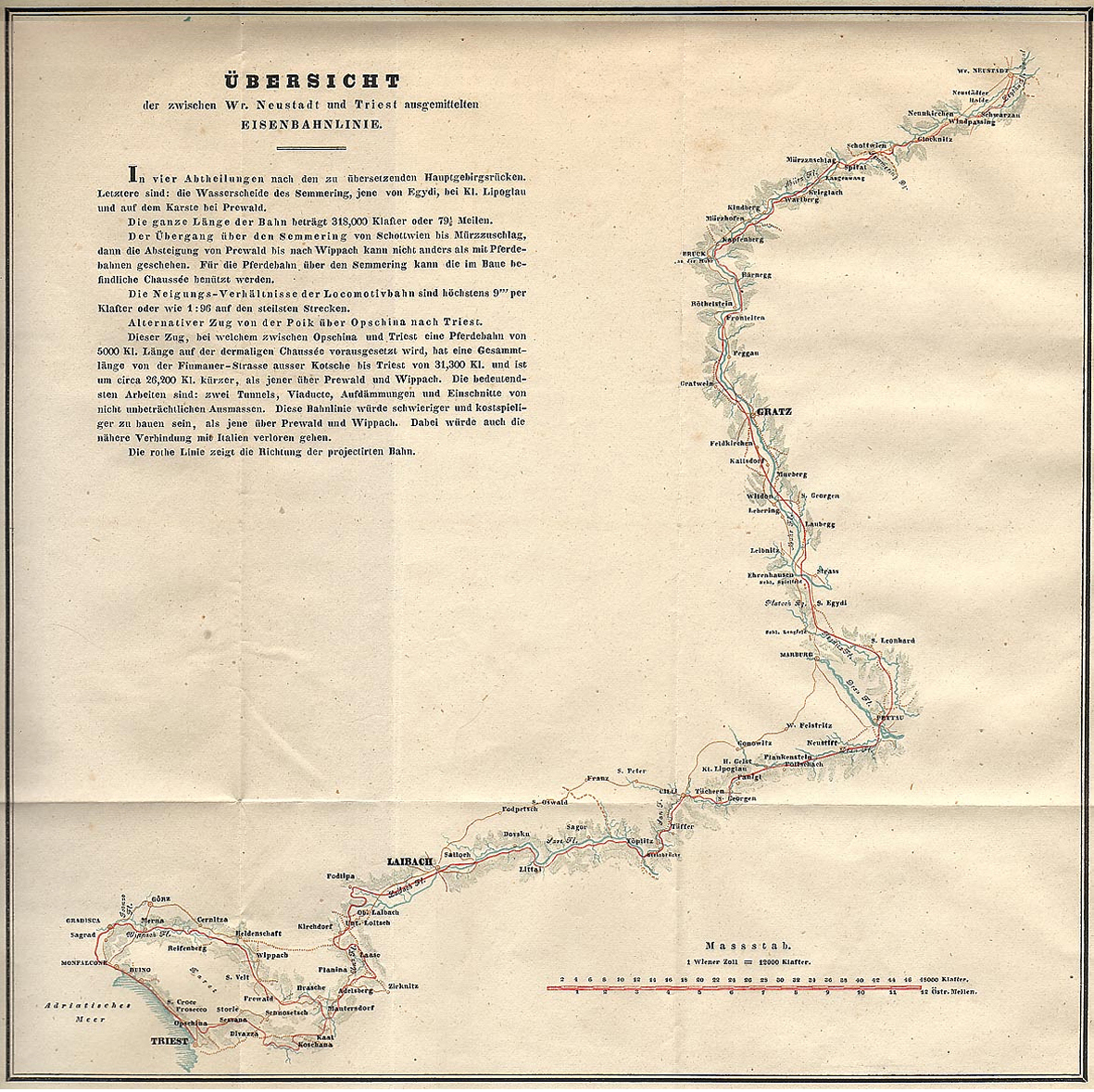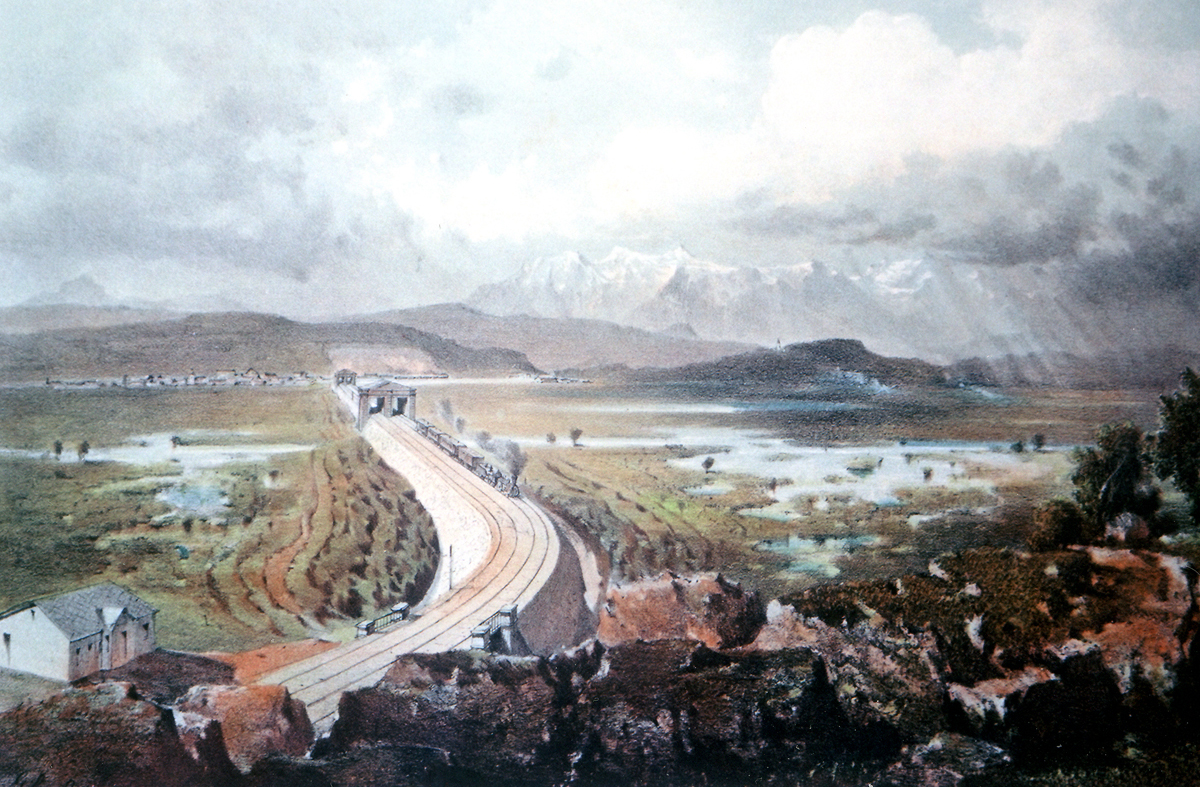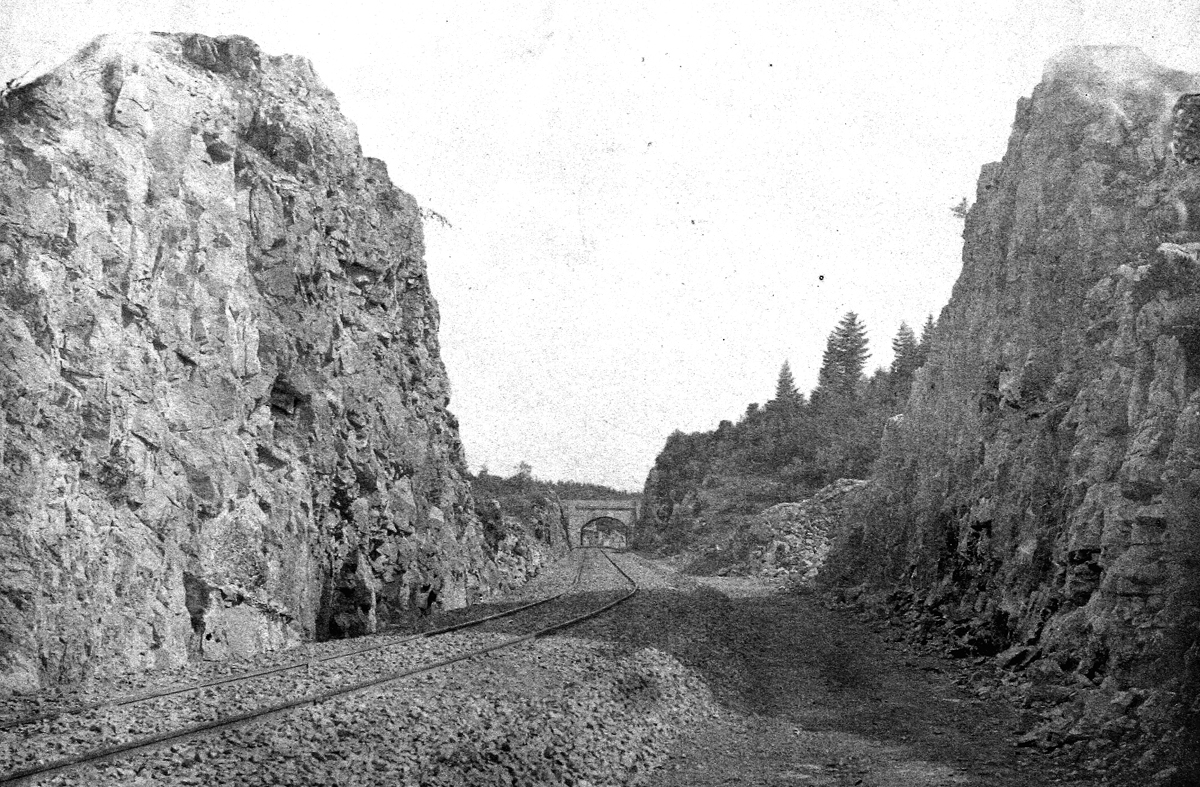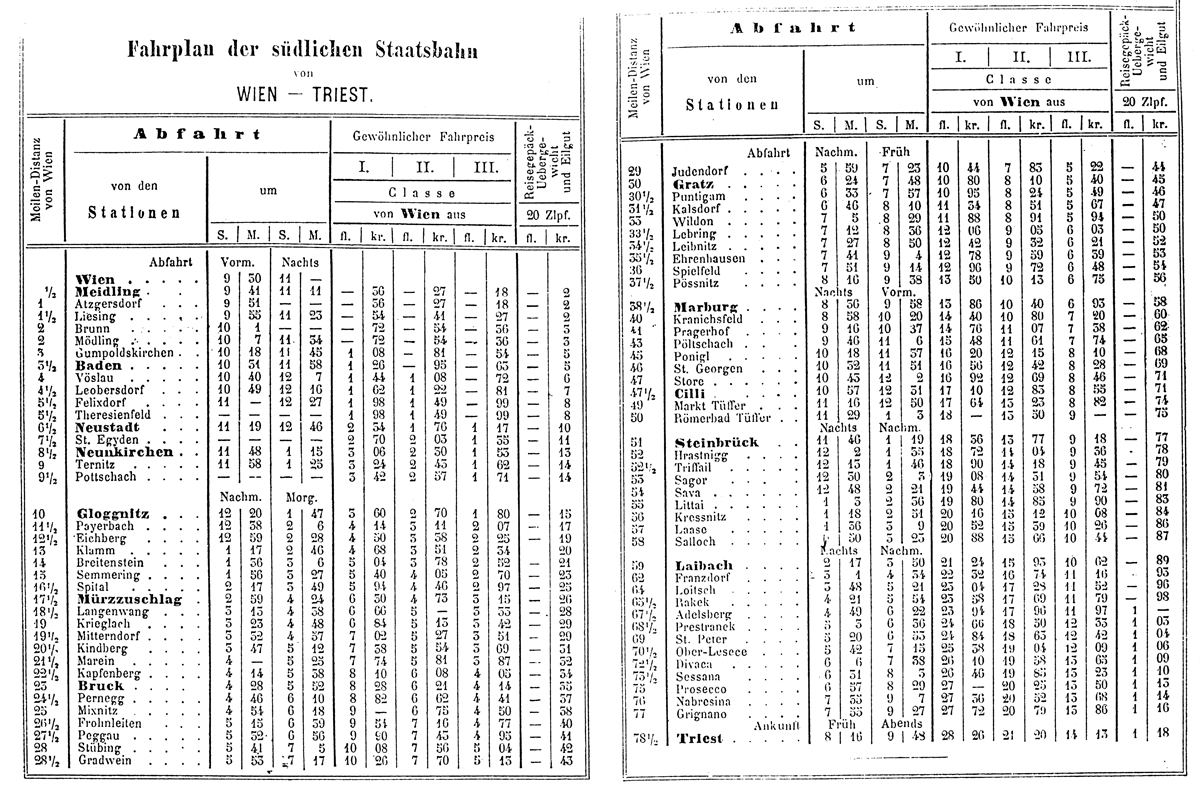
Borovnica railway viaduct 1850 – 1944
From Vienna to Ljubljana
In the 1930s, the railway reached European territory. The Imperial Court of Vienna was aware of the significance of new and faster transport connections between important cities in the Monarchy. It began examining possibilities of connecting Vienna with Trieste. The law on the construction of a two-track (577.2 km long) railway line between Vienna and Trieste was passed on 25 November 1837. The Government sent several experts to the sites of the planned route to investigate them and determine a possible course of the line.
Construction progress
The construction was carried out in six stages from 1839 to 1857:
–Dunaj-WienerNeustadt – Gloggnitz v dolžini 74,8 kilometrov. Gradili so od aprila 1839 do maja 1842
–Mürzzuschlag – Gradec v dolžini 94,7 kilometrov. Gradili so od 1842 do 1844
–Gradec – Celje v dolžini 132,2 kilometra. Gradili so septembra 1843 in končali junija 1846
–Celje – Ljubljana v dolžini 88,7 kilometrov. Gradili so od jeseni 1845 in končali avgusta 1849
–Proga čez Semmering Gloggnitz – Mürzzuschlag v dolžini 41,8 kilometrov. Gradili so od avgusta 1848 do julija 1854
–Ljubljana – Trst v dolžini 144,9 kilometrov. Gradili so od maja 1850 do julija 1857
The construction was carried out in stages. The 74.8 km long section between Vienna and Gloggnitz was completed in May 1842. Due to a demanding section through Semmering, the construction was continued from Mürzzuschlag to Graz, and the 94.7 km long section was completed in 1844. The construction of the 41.8 km long line across Semmering took 6 years, namely from August 1848 to July 1854. A 1428 m long tunnel was built, the longest one in Europe at that time. The Kalte Rinne Viaduct, the length and height of which are 184 m and 46 m respectively, is the highest bridging structure on the Vienna–Trieste line.
The section between Graz and Celje was planned in two directions. The first one was supposed to run through Ptuj, and the second one through Maribor. The latter variant was chosen as it was shorter and more feasible in terms of construction. The works started in September 1843. The Pesnica Viaduct, the tunnel at Šentilj, and the 462 m long Košaki tunnel were major structures in this section. A wooden bridge across the Drava River was built in Maribor. The Pesnica Viaduct made of brick with 66 pillars, the length and height of which were 649 m and 21 m respectively, was one of the longest bridging structures on the entire Vienna–Trieste route. Due to its poor construction, the Viaduct had to be later buried into the embankment. On 1 November 1845, the train on the test run under a personal guidance of the chief line planner, engineer Karl Ghega, ran from Graz to Pesnica. This ride brought the first locomotive to the Slovenian territory. The Graz–Celje section was opened in June 1846.
The 88.7 km long Celje–Ljubljana section caused the line constructors significant trouble. They started working in it already in 1842. Construction of the line began in 1845 and ended in 1849. The variants through Tuhinje Valley and via Vransko to Domžale, respectively, were more feasible; nevertheless, they opted for the route along the Savinja River to Zidani Most and then through the Sava Gorge to Ljubljana. This decision was facilitated by the fact that steam locomotives had to be supplied with coal, while the Zasavje mines were underused due to poor transport connections. The construction in the Savinja and Sava gorges was very demanding. Several bridges were built across the Savinja River, including the famous curved bridge at Zidani Most, and two tunnels and a large bridge at Litija in the Sava Valley.
The Ljubljana railway station was completed on 18 April 1848. It was officially opened on 16 September 1849. The ceremonial train accommodating the Emperor’s messenger, Archduke Albrecht, was pulled to Ljubljana soon after five o’clock p.m. by the locomotives named Laibach (German name for Ljubljana) and Terglav (German name for Triglav).
From Ljubljana to Trieste
The Southern Railway route reached Ljubljana in August 1849. In the same year, Illyrisches Blatt newspaper published a discussion on the directions to construct a new line to Trieste. The railway route between Ljubljana and Trieste caused significant trouble to the planners, who had been studying various directions already since 1842. Crossing the Ljubljana Moors, ascending the Karst plateau, and the lack of water in this area were the main problems they had to deal with. Several different variants were prepared. An extensive article on the Borovnica Viaduct published in Jutro (Morning) newspaper in October 1939 described them as follows: “There were six plans. I can positively say that the bridging structure over the Borovnica Valley and laying the railway across the Ljubljana Moors was not an easy task, considering the technical knowledge and the means available at that time. Therefore, we can follow various variants on where this so important railway should run, starting in 1836 when the first plans had been made for the construction of the line from Vienna to Trieste through our provinces. Archival records show that engineer Fojkar, based in Postojna, was assigned to examine the option of running the line across the Karst area, which was closer to us, in the cut of Iški Vintgar. Several detachments of pioneers explored the site around Logatec, Rakek, Postojna and further in the inner part to find where it would be most convenient to lay the track and break through hard Karst rocks to the Adriatic. I think these had been ordeals, as a new idea occurred in subsequent years: to avoid all the identified difficulties and run the line past Ljubljana, along the Sava River to Gorenjska, past Medvode and Škofja Loka, through Poljanska dolina to the Idrijca riverbed, and from there further to Gorizia and Trieste. When Ljubljana’s commercial circles, i.e. merchants and other interested parties, learned about these plans, about a boycott of the Carniolan capital, they raised the amount of nearly million florins and put them at disposal of the empty state treasury if only the city of Ljubljana gets its railway station at least in the immediate vicinity. At that time, another new route of the over-objectified line occurred right in the route of the current Ljubljana–Vrhnika local railway. From here, the railway should have ascended to Logatec and, according to the plans and advice still kept in the archives, also in the direction of Podlipa and Poljanska dolina. As I already mentioned in a previous article of mine, in 1850, when the decision had already been made on the line, as it runs now, across the Moors and Borovnica, and beyond, Dr Christ August Voigt, professor of anatomy in Vienna, suggested in his private brochure ‘Vorschlag zu einer Eisenbann etc.’ to build the line through underground Karst caves. There are six different variants and plans available, demonstrating the considerations discussed before the final decision for the current route was made.”
The proposal to run the railway to Trieste through Karst caves is definitely a more interesting one. Thorough inspections, including at the field, resulted in two main directions. The first one, called the Soča Route, was supposed to bypass the Ljubljana Moors and turn to Trieste through the Sora and Idrijca valleys near Most na Soči. The second one, also called the Karst Variant, was supposed to run across the Ljubljana Moors to reach the Logatec plateau, past Vrhnika and Podlipa, head to Rakek and Postojna, and from there descend to Trieste. A major change in the decision occurred when Karl Ghega, upon the Baron Kübeck’s order, ordered the Karst Variant to be thoroughly examined. At the conference held in Ljubljana in 1849, a decision was made to run the route through the Ljubljana Moors to Žalostna gora, where it should begin ascending to Borovnica and continue to Logatec and Postojna. According to the constructors, the Karst Variant would have been by 6 miles shorter and 10 million florins cheaper compared to the Soča Variant. The works were planned to be completed in three years, with 28 viaducts and 5 tunnels built during the said period. It turned out later that these calculations had been wrong. In December 1849, Emperor Franz Joseph gave the final approval to the route across Karst. The construction was divided into several sections. Consequently, the construction of the Borovnica Viaduct, the largest bridging structure on the route to Trieste, began in the Žalostna gora–Logatec section.
The most severe construction problem on the Ljubljana–Trieste route was surely the construction of an embankment across the Ljubljana Moors, at its narrowest part, between Notranje Gorice and Preserje. Meanwhile, it was also necessary to bridge the Ljubljanica River. The construction of about 2.5 km long embankment began on both sides. Therefore, quarries were opened in Notranje Gorice and Preserje. Before the embankment was started, it was necessary to dig out drainage ditches on both sides of the Moors. To prevent the soaked clay from forcing to the surface, and to enable the embankment material to sink evenly, stones were placed in the ditches on both sides of the track. This filling up of ditches was carried out until 1854. In the meantime, in 1853, large sinking occurred, and stopped only after three years. The filling material squeezed out the soil on both sides of the line and laid on hard layers in the depths. Almost 200,000 m3 of material were used for the entire embankment.
Further from Žalostna gora, the line ascends through slopes of the hills to Borovnica. The Borovnica Valley was bridged in a curve by the 560 m long and 38 m high mighty Viaduct. To cross the valleys, it was necessary to build as many as five viaducts right in the neighbourhood of Borovnica. Beyond Borovnica, the railway ascends in the direction of Logatec and Postojna. To cross the valley with the road to Trieste, they built the Štampet Bridge, under which the Ljubljana–Koper motorway runs today. At Postojna, the line reaches its highest point and begins descending towards the sea. To cross sinkholes, six tunnels and several rocky embankments were built between Pivka and Košana. Several wind-breaking walls were erected to shelter against the Karst bora. Near Nabrežine, large supplies of drinking water were discovered, and the Trieste water supply system was built from there. Two large viaducts were built at Nabrežine and Barkovlje near Trieste, and they were followed by a 275 m long tunnel. The Vienna–Trieste line was officially opened on 27 July 1857 with the arrival of the train carrying the Emperor in Trieste.
The train from Vienna to Trieste and back ran three times a day. Unlike the horse-drawn carriage, which took as much as 8 days to travel, the fast train took “only” 16 hours, and the regular passenger train 24 hours. Passengers could choose between three classes, and children up to two years had a 50 % discount.
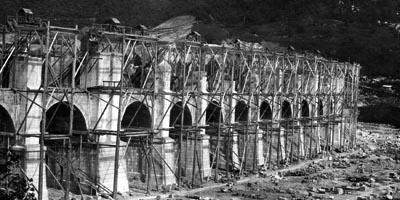
The Viaduct Construction
The Borovnica Viaduct used to be the largest bridging structure in the Southern Railway route between Vienna and Trieste…

Borovnica
At that time, Borovnica, a small village in the southern part of the Ljubljana Moors, had about fifty houses…

The life of Viaduct
The railway line over the Borovnica and other viaducts was insulated with compacted clay…
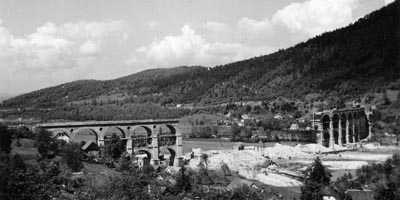
The Second World War
On Easter Thursday, 10 April 1941, at five o’clock p.m., the Borovnica Viaduct was blasted under the command of Captain Žužek…
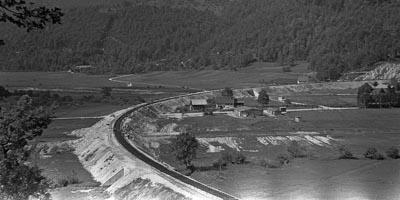
The construction of a new line
Borovnica was liberated on 6 May 1945, when it was entered by units of the 29th Herzegovina’s Strike Division…

This website is a part of the project »Thematic Park and Memorial Path of Borovnica Viaduct«, co-financed by the European Fund
for Regional Development (EFRD) throught the Local Action Group Barje z zaledjem.





